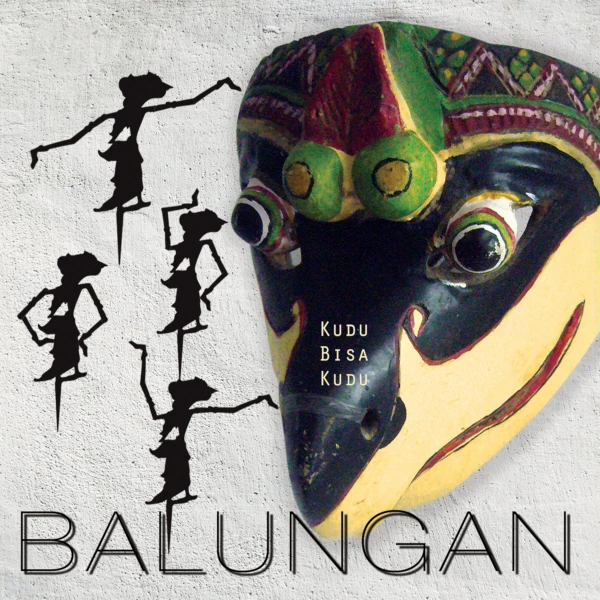
Exposé Online
What's old
Exposé print issues (1993-2011)
- 1 (October 1993)
- 2 (February 1994)
- 3 (May 1994)
- 4 (August 1994)
- 5 (October 1994)
- 6 (March 1995)
- 7 (July 1995)
- 8 (November 1995)
- 9 (March 1996)
- 10 (August 1996)
- 11 (February 1997)
- 12 (May 1997)
- 13 (October 1997)
- 14 (February 1998)
- 15 (July 1998)
- 16 (January 1999)
- 17 (April 1999)
- 18 (November 1999)
- 19 (May 2000)
- 20 (October 2000)
- 21 (March 2001)
- 22 (July 2001)
- 23 (December 2001)
- 24 (April 2002)
- 25 (September 2002)
- 26 (February 2003)
- 27 (August 2003)
- 28 (December 2003)
- 29 (April 2004)
- 30 (September 2004)
- 31 (March 2005)
- 32 (September 2005)
- 33 (May 2006)
- 34 (March 2007)
- 35 (January 2008)
- 36 (October 2008)
- 37 (July 2009)
- 38 (July 2010)
- 39 (Summer 2011)
Reviews
Balungan — Kudu Bisa Kudu
(Cuneiform Rune, 2022, CD / DL)
by Peter Thelen, Published 2022-05-02

Indonesia has a long heritage of indigenous music, much of it virtually unknown in the West: the ‘bamboo bells’ of angklung; the kolintang — a wooden mallet instrument; the bamboo tubular stringed zither called the sasando, as well as wooden flutes, gongs, drums, and more. But perhaps the best known of them all is the gamelan ensemble, usually consisting of numerous players, the main instrument being metallophones (a gender) fitted with bronze or copper bars suspended over bamboo or metal resonators, struck with various wooden mallets, along with groups of tuned gongs, tuned log drums, and more, all tuned to a five-note scale. Traditionally, a gamelan ensemble, characterized by complex polyrhythms, is used to accompany dancing, theatrical productions, shadow puppets, and more, often accompanied by singing. There are slightly different versions of the gamelan ensemble in different parts of Indonesia; the best known are Sundanese (Western Java), Balinese (from the island of Bali, characterized by a more harsh metallic sound), and the somewhat softer sounding gamelan of central Java — based in Yogyakarta, a city with a rich history that operated for several centuries as a nominally independent kingdom, even during Dutch colonial rule. There have been numerous attempts to fuse the gamelan ensemble with more Western forms of music over the years, some examples include Eberhard Schoener’s 1976 masterwork Bali-Agung, and the American world music band Ancient Future on their 1993 album Asian Fusion; but also several Indonesian musicians have fused gamelan sounds into their own music, including guitarists Balawan, Dewa Budjana, the band Discus, and others.
The group at hand, Balungan, came together over a period of time following French drummer Guigou Chenevier (of the band Etron Fou Leloublan and many other projects) responding to a call for a gamelan workshop in Marseilles. One thing led to another, and Chenevier and five other French musicians ended up in Yogyakarta teaming up with seven Javanese gamelan players to create this thirteen-piece ensemble fusing Indonesian traditional sounds with rock music. This isn’t rock music with gamelan tacked on, nor is it traditional gamelan music played by a rock band; the group was built from the ground up, each member contributing their original material and instrumentation, each contributing lyrics in their own language, and the arrangements done together as a group, refined over six alternating sessions in France and Indonesia, where the Balungan musical vision came together over the period of a few years. Several concerts were given in both countries, but the recording at hand, live at La Garance, dates from May 23rd, 2017, a technically flawless recording that stands as one of the best gamelan-rock fusions one is likely to hear anywhere, and these guys do rock — each of the twelve tracks is are overflowing with energy, urgency, and power. Standout reacks include "Bruits d'Éclats," the slow building "Kethek Saranggon," the high energy closer "Kangen," "Poulet Mort," and the moody electronic based "Meet." but honestly there isn't a bad song among them all. There is a stunning amount of variety in the compositions, but they all fit together beautifully. Kudu Bisa Kudu is like no other, and perhaps my number one contender for album of the year.
Filed under: New releases, 2022 releases
Related artist(s): Balungan
More info
http://cuneiformrecords.bandcamp.com/album/kudu-bisa-kudu-2
What's new
These are the most recent changes made to artists, releases, and articles.
- Listen and discover: They're schizo, they're fun, and they're dreaming
Published 2026-01-02 - Review: Zabrahana - Whales Dream in Purple
Published 2026-01-02 - Review: McLuhan - Anomaly
Published 2026-01-01 - Review: Ektör - Ektöristan
Published 2025-12-31 - Release: Chatte Royal - Mick Torres Plays Too F***ing Loud
Updated 2025-12-30 15:33:15 - Artist: Chatte Royal
Updated 2025-12-30 15:32:15 - Release: Olly Chalk - In Those Remote Stars
Updated 2025-12-30 14:01:10 - Artist: Olly Chalk
Updated 2025-12-30 13:59:56 - Review: Pietro Zollo - The Future Is Now
Published 2025-12-30 - Release: Dhope - Musical Exhibitions
Updated 2025-12-29 23:00:53 - Release: Tin Pan Alley - Tin Pan Alley
Updated 2025-12-29 22:51:10 - Release: Jeff Pearce - Infinite Ambient: Winter Landscapes
Updated 2025-12-29 22:33:12 - Release: Trio of Bloom - Trio of Bloom
Updated 2025-12-29 17:19:40 - Artist: Trio of Bloom
Updated 2025-12-29 17:16:50 - Artist: Craig Taborn
Updated 2025-12-29 17:02:15 - Release: Family - Old Songs, New Songs
Updated 2025-12-29 00:03:41 - Review: The Kirkbys - It's a Crime: The Complete Recordings
Published 2025-12-29 - Release: Various Artists - Psychedelic Underground 20
Updated 2025-12-28 23:33:26 - Artist: Dhope
Updated 2025-12-28 23:27:49 - Artist: Tin Pan Alley
Updated 2025-12-28 23:21:39
